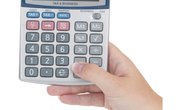
Dividing large numbers is a complex process that can become difficult for some students. The division process involves many different steps that must be completed in the correct order, and this process must be practiced to ensure mastery. Students usually become confused with the long division process because they cannot remember the order that the steps must be completed. Fortunately, many students can become proficient with the long division process by remembering the mnemonic sentence, "Does McDonald's Serve Cheese Burgers?" and using it as a step-by-step guide when dividing large numbers.
Make sure that students have a strong foundational knowledge of the vocabulary used in long division. This includes divisor, dividend and quotient.
Provide students with a reference sheet that correlates the mnemonic sentence with the division steps. For example, Does (Divide) McDonald's (Multiply) Serve (Subtract) Cheese (Compare) Burgers (Bring Down). This will allow them to instruct themselves during independent practice time.
Divide the first number of the dividend by the divisor. The dividend is the number inside of the division symbol and the divisor is the number outside and to the right of the division symbol. For example, If you're solving the problem 59 divided by four, you divide five by four. Four fits into five one time, so a 1 is placed on top of the division symbol directly above the five in 59.
Multiply the number on top of the division symbol (the quotient) by the divisor. In this case, one is multiplied by four with a result of four. Four is then placed directly below the five in the divisor.
Subtract the number placed below the dividend from the first number in the dividend. For example, four is subtracted from five with a result of one.
Compare the subtracted answer to make sure that it is not bigger than the divisor. For example, one is compared with four and it is verified that it is indeed smaller than the divisor, four. If the subtracted answer is larger than the divisor, the student needs to find and fix the mistake in either the division or multiplication step.
Bring down the number to the right in the dividend and place it next to the subtracted answer. For example, the nine in the dividend 59 is brought down and placed next to the 1 to form the number 19.
Repeat this process until all of the numbers in the dividend have been brought down. For example, the division step would start over using the number 19. When the final subtracted number is less than the divisor, this number becomes the remainder and the problem is solved.
Tips
References
- "Math at Hand"; Sandra P. Alley; 1999
Tips
- Make sure that students have a strong foundational knowledge of the vocabulary used in long division. This includes divisor, dividend and quotient.
- Provide students with a reference sheet that correlates the mnemonic sentence with the division steps. For example, Does (Divide) McDonald's (Multiply) Serve (Subtract) Cheese (Compare) Burgers (Bring Down). This will allow them to instruct themselves during independent practice time.
About the Author
Stephen Hart has been writing for eHow since 2011. He received his Bachelor of Arts in elementary education from Washington State University in 2009 and is currently pursuing his special education certification.
Photo Credits
Brand X Pictures/Brand X Pictures/Getty Images
